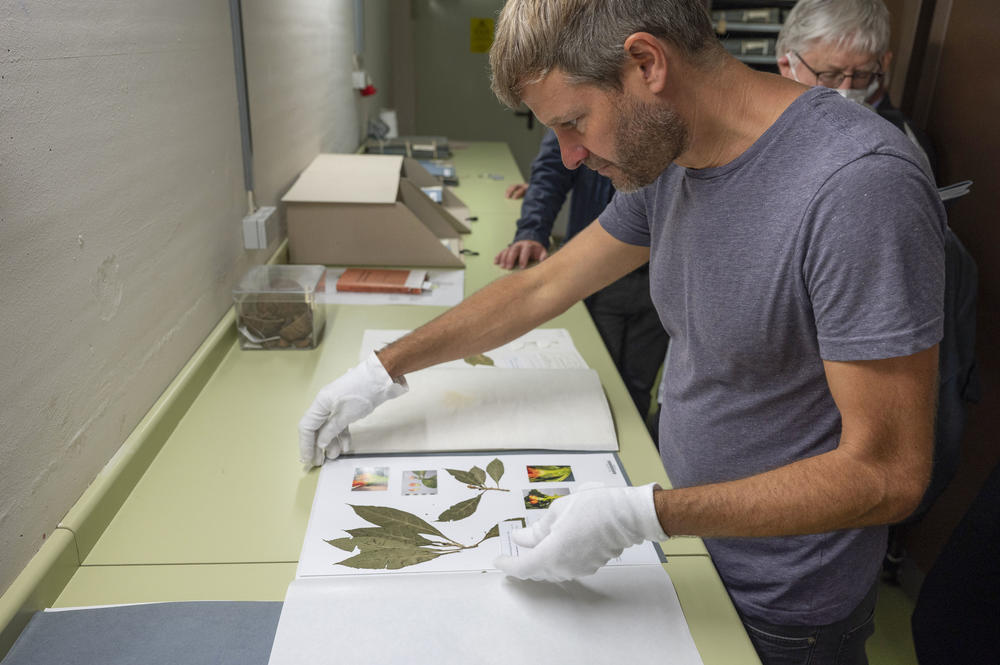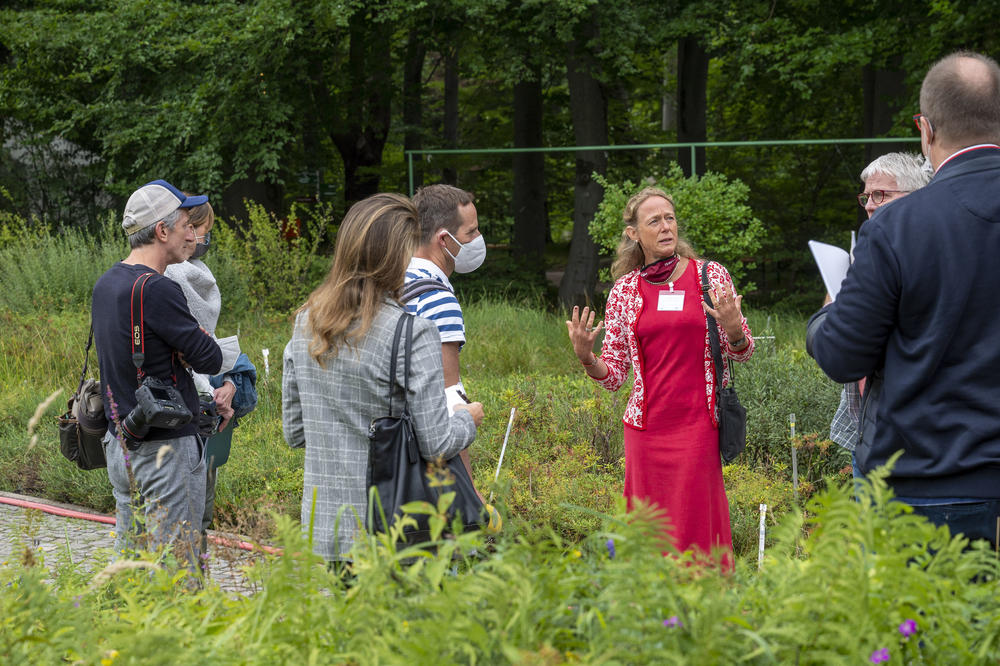Growing Knowledge in the Botanic Garten
The Botanic Garden of the future will be linked with the world: Digitizing the herbarium will facilitate important insights into preserving biodiversity
Oct 22, 2021
The cactus conservatory presents dry habitats of the New World with cacti, agaves, and other succulent plants. Other greenhouses display the flora of the wet tropics and subtropics. The heart of the complex is the Großes Tropenhaus.
Image Credit: Christiane Patic
Nils Köster takes a folder with the number 9442 from a shelf in the herbarium. Wearing white cloth gloves, he opens it and places a yellowed slip of paper on the table. A dried leaf is glued to the center of the page, and in a tiny envelope below that is a dried white petal of the corresponding blossom. This document, which is over 200 years old, is the first scientific evidence of the Cactus bleo.
It is one of about 3,300 plant specimens in the herbarium of the Berlin Botanic Garden Berlin of Freie Universität that Alexander von Humboldt and his assistent Aimé Bonpland brought back from their arduous trips to South America. “While they pressed and described the plants, they were probably crouching in a small hut with high humidity and candlelight, tormented by mosquitoes,” says Nils Köster, curator for tropical and subtropical living plant collections at the Botanic Garden.
Nils Köster, curator for tropical and subtropical living plant collections, examines historic herbarium specimens.
Image Credit: Bernd Wannenmacher
Collecting journeys in the spirit of Alexander von Humboldt continue to take place with partners in many countries, and they contribute to the steady growth of the plant collections in Berlin and other institutions. To facilitate access by scientists in the country of origin and in Berlin, plant specimens are collected in duplicates, of which one set is deposited in the partner institution and one in Berlin. Today, however, the combination of field research and digitization opens up new possibilities. Scientists from anywhere in the world can examine plant specimens while sitting conveniently at their computers. The specimens that Humboldt brought to Berlin have been freely accessible as high-resolution photos on the Internet for some time now.
The remaining dried and preserved plant specimens in Germany’s largest herbarium are still being digitized. So far, only 20 percent are in the database. The aim is for the complete collection to be in the database within ten years: a total of around 4 million plant specimens from all over the world.
The director of the Botanic Garden, Thomas Borsch, presented his plans for the future development of the Botanic Garden and Botanical Museum to the public.
Image Credit: Bernd Wannenmacher
Digitizing the collections is just one of the projects that the Berlin Botanic Garden is planning to prepare for the future. Founded more than 300 years ago in Schöneberg, the Botanic Garden opened in the new location in Dahlem 110 years ago and has been part of Freie Universität Berlin since 1995. “We preserve knowledge, we increase knowledge, and we share it with the world,” says Professor Thomas Borsch.
Future Development Plan of the Botanic Garden
The director of the Berlin Botanic Garden recently presented to the public a new concept that the traditional institution has developed to meet the great social challenges of our time. The concept includes expanded offers such as new exhibition boards throughout the entire open space and presenting visitors with more information about species protection and environmental protection. Both the gardens and the museum are part of a plan to become more visible as a location for social discourse about biodiversity and its significance.
More than 17 million euros will flow into the development of the gardens by 2023 from funds from the Joint Task Improvement of the Regional Economic Structure (GRW). The new visitor center at the Königin-Luise-Strasse entrance is due to open in the spring of 2022 – a light building with a wooden roof and courtyard garden. The Botanical Museum will be redesigned and rebuilt by 2023.
Botanic Garden as Engine for Biodiversity Research
In the 21st century, botanic gardens can make important contributions to the great questions of biodiversity research through research on their collections. How many species are there? Where do they appear? How great is their genetic diversity? Bringing the wealth of knowledge from the herbaria in Germany and around the world together offers great potential for researchers to benefit from enormous data sets.
“Data not only have to be openly accessible internationally, but also standardized and networked,” says Thomas Borsch. This includes creating a global data infrastructure with the help of the newly established Center for Biodiversity Informatics and Collection Data Integration. Different data types should be able to be linked with one another in such a way that new knowledge can emerge.
350,000 Land Plants
Botanists all over the world are working to record the diversity of plants on Earth because scientists do not currently know the exact extent of global biodiversity. Around 350,000 species of land plants – mosses, ferns, and flowering plants – are currently scientifically accepted. Around 2000 new discoveries are made every year.
Even well-known species need to be differentiated from one another using modern methods. “This is a matter of digitally linking objects with molecular DNA sequences that can be used to specifically clarify relationships,” says Thomas Borsch. “On the basis of these findings, it is possible to look specifically at which individual plants belong to a species and how they are spread around the world in order to gain new knowledge for species protection.”
Elke Zippel, curator of the Dahlem Seed Bank, is an expert on the conservation of endangered native wild plants.
Image Credit: Bernd Wannenmacher
This type of information is urgently needed because numerous studies in recent years have indicated there is a massive decline in many species. The current destruction of living space – through deforestation, intensification of agriculture, soil sealing, mining of mineral resources, and much more – leads to severe losses in biological diversity.
With the help of “Big Data,” in the future computer models may be able to provide information about the decline or the increased spread of certain species in connection with climatic changes.
Plant Treasures Are Stored in the Seed Bank
The Dahlem Seed Bank, which is also part of the Berlin Botanic Garden, makes an important contribution toward protecting biodiversity. Thousands of samples of wild plant seeds are stored there. Many of them come from rare and endangered species. They are available for research, and they are also used to reintroduce threatened plants. In order for the reintroduction and population support of plants to be successful in the long term, they must be monitored scientifically. For example, the last seeds of the scented scabies – an herbaceous plant that grows up to 50 centimeters high – were re-introduced into a living population in Berlin.
This text originally appeared in German on October 2, 2021, in the Tagesspiegel newspaper supplement published by Freie Universität Berlin.
Further Information
The main entrance of the Botanic Garden at Königin-Luise-Straße 6-8 is open daily from 9 a.m. to 8 p.m. for a visit. Please book an online ticket. Admission: 6/3 euros, www.bo.berlin




